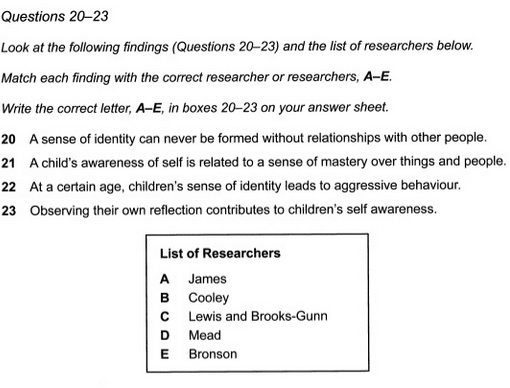Matching features - Nối đặc điểm là dạng bài yêu cầu bạn phải tìm thông tin cụ thể về đặc điểm của một người/địa điểm/điều nổi bật trong bài. Đề bài cung cấp các danh từ riêng, bạn có nhiệm vụ nối chúng với những câu mang thông tin miêu tả đặc điểm nổi bật nhất của danh từ đó.
Format Matching features
Các feature đực đưa ra có thể là tên người ( thường là nhà nghiên cứu, nhân vật lịch sử,…) và các câu xuất hiện trong đoạn văn ( dới dạng paraphrasing). Nhiệm vụ của bạn là nối thông tin được cho với 1 thông tin trong “list” sao cho phù hợp. Bài thi đánh giá khả năng nhận dạng mối liên hệ giữa các kết nối bài, có thể tìm ra các thông tin chi tiết của bài nhanh chóng.

Chiến thuật làm bài
Để làm bài IELTS Reading dạng này, chúng ta theo 4 bước này nhé:
Bước 1: Đọc kỹ câu hỏi
Bước 2: Scan và đánh dấu các lựa chọn xuất hiện trong toàn bộ bài đọc
Bước 3: Đọc kỹ câu hỏi- statements, gạch chân từ khóa
Bước 4: Đối chiếu statements với thông tin và lựa chọn đáp án
Cùng phân tích qua ví dụ sau:
Read the following text and do the task below
Follow your nose
B. Behavioural studies have consistently shown that odours elicit emotional memories far more readily than other sensory cues. And earlier this year, Rachel Herz, of Brown University in Providence, Rhode Island, and colleagues peered into people's heads using functional Magnetic Resonance Imaging (fMRI) to corroborate that. They scanned the brains of five women while they either looked at a photo of a bottle of perfume that evoked a pleasant memory for them, or smelled that perfume. One woman, for instance, remembered how as a child living in Paris—she would watch with excitement as her mother dressed to go out and sprayed herself with that perfume. The women themselves described the perfume as far more evocative than the photo, and Herz and co-workers found that the scent did indeed activate the amygdala and other brain regions associated with emotion processing far more strongly than the photograph. But the interesting thing was that the memory itself was no better recalled by the odour than by the picture. "People don't remember any more detail or with any more clarity when the memory is recalled with an odour," she says. "However, with the odour, you have this intense emotional feeling that's really visceral."
Look at the following findings (Questions 1-6and the list of researchers.
Match each finding with the correct researcher, A-D.
Write the correct letter, A-D, in boxes 1-6 on your answer sheet.
NB You may use any letter more than once.
1. Smell can trigger images of horrible events.
2. Memory cannot get sharper by smell.
A. Rachel Hertz
B. Eric Vermetten
C. Gil Morrot
D. Jay Gottfried and Ray Dolan
Bước 1. Đọc kỹ câu hỏi
Bài yêu cầu chúng ta nối tên các nhà nghiên cứu với những khám phá của họ sao cho phù hợp.
Bước 2. Scan và đánh dấu
các lựa chọn xuất hiện trong toàn bộ bài đọc
Việc đánh dấu các lựa chọn sẽ giúp tiết kiệm thời gian khi làm bài, khi đó, chúng ta sẽ chỉ tập trung vào các thông tin ngay xung quanh các lựa chọn và khoanh vùng.
Đánh dấu các lựa chọn ( là tên của các nhà nghiên cứu) vào đoạn văn:
Behavioural studies have consistently shown that odours elicit emotional memories far more readily than other sensory cues. And earlier this year, Rachel Herz, of Brown University in Providence, Rhode Island, and colleagues peered into people's heads using functional Magnetic Resonance Imaging (fMRI) to corroborate that. They scanned the brains of five women while they either looked at a photo of a bottle of perfume that evoked a pleasant memory for them, or smelled that perfume. One woman, for instance, remembered how as a child living in Paris—she would watch with excitement as her mother dressed to go out and sprayed herself with that perfume. The women themselves described the perfume as far more evocative than the photo, and Herz and co-workers found that the scent did indeed activate the amygdala and other brain regions associated with emotion processing far more strongly than the photograph. But the interesting thing was that the memory itself was no better recalled by the odour than by the picture. "People don't remember any more detail or with any more clarity when the memory is recalled with an odour," she says. "However, with the odour, you have this intense emotional feeling that's really visceral."
Bước 3. Đọc kỹ statement và gạch chân từ khóa
Từ khóa thường là chủ ngữ, động từ chính và các cụm danh từ, hoặc các cụm phủ định.
Hãy gạch chân từ khóa trong statements.
1. Smell can trigger images of horrible events.
2. Memory cannot get sharper by smell.
Bước 4. Đối chiếu statements
với thông tin trong đoạn văn đã khoanh vùng và lựa chọn đáp án
Thông tin trong statements có thể đã được paraphrasing, do vậy hãy tìm câu chứa thông tin được paraphrase và đối chiếu.
Trong đoạn vừa rồi không đề cập đến câu 1 “Smell can trigger images of horrible events”.
Xét câu 2 “Memory cannot get sharper by smell”.
Trong đoạn văn có câu: “But the interesting thing was that the memory itself was no better recalled by the odour than by the picture.”
Cannot get sharper= no better recalled…..than…..
Oudour = smell
Câu 2 này có chứa thông tin của đoạn văn và thuộc nghiên cứu của Rachel Hertz.
Đáp án là 2- A
Check-up Matching Features
Read the passage and do the task
Follow your nose
A. Aromatherapy is the most widely used complementary therapy in the National Health Service, and doctors use it most often for treating dementia. For elderly patients who have difficulty interacting verbally, and to whom conventional medicine has little to offer, aromatherapy can bring benefits in terms of better sleep, improved motivation, and less disturbed behaviour. So the thinking goes. But last year, a systematic review of health care databases found almost no evidence that aromatherapy is effective in the treatment of dementia. Other findings suggest that aromatherapy works only if you believe it will. In fact, the only research that has unequivocally shown it to have an effect has been carried out on animals.
B. Behavioural studies have consistently shown that odours elicit emotional memories far more readily than other sensory cues. And earlier this year, Rachel Herz, of Brown University in Providence, Rhode Island, and colleagues peered into people's heads using functional Magnetic Resonance Imaging (fMRI) to corroborate that. They scanned the brains of five women while they either looked at a photo of a bottle of perfume that evoked a pleasant memory for them, or smelled that perfume. One woman, for instance, remembered how as a child living in Paris—she would watch with excitement as her mother dressed to go out and sprayed herself with that perfume. The women themselves described the perfume as far more evocative than the photo, and Herz and co-workers found that the scent did indeed activate the amygdala and other brain regions associated with emotion processing far more strongly than the photograph. But the interesting thing was that the memory itself was no better recalled by the odour than by the picture. "People don't remember any more detail or with any more clarity when the memory is recalled with an odour," she says. "However, with the odour, you have this intense emotional feeling that's really visceral."
C. That's hardly surprising, Herz thinks, given how the brain has evolved. "The way I like to think about it is that emotion and olfaction are essentially the same thing," she says. "The part of the brain that controls emotion literally grew out of the part of the brain that controls smell." That, she says, probably explains why memories for odours that are associated with intense emotions are so strongly entrenched in us, because smell was initially a survival skill: a signal to approach or to avoid.
D. Eric Vermetten, a psychiatrist at the University of Utrecht in the Netherlands, says that doctors have long known about the potential of smells to act as traumatic reminders, but the evidence has been largely anecdotal. Last year, he and others set out to document it by describing three cases of post-traumatic stress disorder (PTSD) in which patients reported either that a certain smell triggered their flashbacks, or that a smell was a feature of the flashback itself. The researchers concluded that odours could be made use of in exposure therapy, or for reconditioning patients' fear responses.
E. After Vermetten presented his findings at a conference, doctors in the audience told him how they had turned this association around and put it to good use. PTSD patients often undergo group therapy, but the therapy itself can expose them to traumatic reminders. "Some clinicians put a strip of vanilla or a strong, pleasant, everyday odorant such as coffee under their patients' noses, so that they have this continuous olfactory stimulation." says Vermetten. So armed, the patients seem to be better protected against flashbacks. It's purely anecdotal, and nobody knows what's happening in the brain, says Vermetten, but it's possible that the neural pathways by which the odour elicits the pleasant, everyday memory override the fear-conditioned neural pathways that respond to verbal cues.
F. According to Herz, the therapeutic potential of odours could lie in their very unreliability. She has shown with her perfume-bottle experiment that they don't guarantee any better recall, even if the memories they elicit feel more real. And there's plenty of research to show that our noses can be tricked, because being predominantly visual and verbal creatures, we put more faith in those other modalities. In 2001, for instance, Gil Morrot, of the National Institute for Agronomic Research in Montpellier, tricked 54 oenology students by secretly colouring a white wine with an odourless red dye just before they were asked to describe the odours of a range of red and white wines. The students described the coloured wine using terms typically reserved for red wines. What's more, just like experts, they used terms alluding to the wine's redness and darkness—visual rather than olfactory qualities. Smell, the researchers concluded, cannot be separated from the other senses.
G. Last July, Jay Gottfried and Ray Dolan of the Wellcome Department of Imaging Neuroscience in London took that research a step further when they tested people's response times in naming an odour, either when presented with an image that was associated with the odour or one that was not. So, they asked them to sniff vanilla and simultaneously showed them either a picture of ice cream or of cheese, while scanning their brains in a fMRI machine. People named the smells faster when the picture showed something semantically related to them, and when that happened, a structure called the hippocampus was strongly activated. The researchers' interpretation was that the hippocampus plays a role in integrating information from the senses— information that the brain then uses to decide what it is perceiving.
Look at the following findings (Questions 1-6) and the list of researchers.
Match each finding with the correct researcher, A-D.
Write the correct letter, A-D, in boxes 1-6 on your answer sheet.
NB You may use any letter more than once.
1. Smell can trigger images of horrible events.
2. Memory cannot get sharper by smell. Example 2- A
3. When people are given an odour and a picture of something to learn, they will respond more quickly in naming the smell because the stimulus is stronger when two or more senses are involved.
4. Pleasant smells counteract unpleasant recollections.
5. It is impossible to isolate smell from visual cues.
6. The part of brain that governs emotion is more stimulated by a smell than an image.
A. Rachel Hertz
B. Eric Vermetten
C. Gil Morrot
D. Jay Gottfried and Ray Dolan
Mẹo làm bài Matching Features
Những vấn đề thường mắc phải khi làm dạng bài này
Khi làm dạng bài này, thí sinh thường hay mắc phải những lỗi dưới đây:
- Đọc hết toàn bộ bài đọc: Điều này thực tế với những ai mới học Reading và không có nhiều kỹ năng đều mắc phải. Bạn nên học cách Scan để tìm thông tin thì sẽ hiệu quả hơn.
- Không đọc kỹ các đoạn chứa phần lựa chọn nên đọc sai.
- Không chú ý đến các từ đồng nghĩa, chỉ chú trọng các từ chính xác
- Với dạng bài này, câu hỏi sẽ không theo trật từ vì thế các bạn cần chú ý.
Tips làm bài
Khi làm bài, các bạn có thể áp dụng những mẹo dưới đây:
- Hãy xác định ngữ cảnh – không nối từ (word match)
Ví dụ như sau:
Questions 34-40
Look at the following statements (Questions 34-40) and the list of countries below.
Match each statement with the correct country, A-J.
Write the correct letter, A-J, in boxes 34-40 on your answer sheet.
NB You may use any letter more than once.
A. George Stephenson
B. Richard Trevithick
C. Archimedes
D. James Watt
E. The Corinthians
F. John Fitch
And you have to match them to items in the text:
1. was responsible for building a life size steam locomotive
2. legally protected the design of the working model of the steam locomotive
3. created a small scale replica of a steam locomotive
4. was defeated by the limitations of the raw materials available to him
5. understood the potential of steam locomotives to transport people
6. used steam as a form of propulsion
7. discovered how to use steam engines in the manufacturing industry
8. used animals and not steam to power a form of railway
Phân tích câu sau:
“ The first step was the design of a working model of a steam locomotive by John Fitch in the United States in 1794.”
Bạn có thể suy ra rằng câu trên có thể nối John Fitch với đáp án số 2. Bạn có thể thấy: “the design of the working model of the steam locomotive” và “legally protected the design of the working model of the steam locomotive” có vẻ có nhiều từ giống nhau. Tuy nhiên, không có thông tin nào thể hiện ý rằng Fitch legally protected the design cả.
- Tìm đọc từ đồng nghĩa – Đừng nối từ (match words)
Việc tìm từ đồng nghĩa thay vì tìm từ đúng chính xác trong câu hỏi sẽ giúp bạn chọn đáp án đúng hơn vì hầu hết bài đọc sẽ thay thế từ đồng nghĩa.
Ví dụ như sau:
Câu 8: used animals and not steam to power a form of railway
Bạn tìm từ “animals” sẽ không có được vì trong bài văn sẽ không xuất hiện từ đó mà sẽ là:
“The Corinthians did not consider using steam to power this prototype of the railway but instead used horses and oxen”.
- Luyện kỹ năng Scan
Như đã nói, câu hỏi Matching features không theo trình tự bài đọc vì thế mà bạn sẽ phải đọc lại đoạn văn nhiều lần. Nhưng nếu đọc nhiều lần sẽ khiến bạn “loạn” thậm chí còn không đủ thời gian. Vì thế, bạn cần luyện kỹ năng Scan.
Luyện tập có đáp án
Look at the following characteristics (Questions and the list of sub-families below). Match each characteristics with the correct answer.
Write the correct letter, A-D, in boxes 1-5 on your answer sheet. NB You may use any letter more than once.
1. can survive in harsh habitats.
2. move at a high speed.
3. origins of modern ox and cow.
4. does not defend a particular area of land.
5. sometimes take small animals as their food supply.
A. Bovinae
B. Antelope
C. Caprinae
D. Cephalophinae
Bovid
A bovid is any member of almost 140 species of ungulates belonging to the family Bovidae. The bovids are the largest family of hoofed mammals and are native to Africa, Europe, Asia, and North America. Members include antelope, bison, buffalo, cattle, sheep and goats. Bovids have mutually beneficial symbiotic relationships with bacteria and other microorganisms that allow the digestion of cellulose, the most abundant form of living terrestrial biomass, but one that is indigestible for many animals, including humans.
Bovids are not so common in endemic insular faunas and are mainly recorded in Southeast Asia, Japan and some Mediterranean islands. Ely the late Miocene, the bovids rapidly diversified, leading to the creation of 70 new genera. This late Miocene radiation was partly because most bovids became adapted to more open, grassland habitats. Some species of bovid are solitary, but others live in large groups with complex social structures.
All bovids have the similar basic form—a snout with a blunt end, one or more pairs of horns immediately after the oval or pointed ears, a distinct neck and and a tail varying in length and bushiness among the species. However, the bovids show great variation in size: the gaur can weigh as much as 1,000kg and stands 2-3m high at the shoulder. The royal antelope, at the opposite extreme, is only 25cm tall and weighs at most 3kg.
Despite differences in size and appearance, bovids are united by the possession of certain common features. Being ruminants, the stomach is composed of four chambers: the rumen (80%), the omasum, the reticulum, and the abomasum. Bovids retain undigested food in their stomachs to be regurgitated and chewed again as necessary Bovids are almost exclusively herbivorous. Most bovids bear 30 to 32 teeth. While the upper incisors are absent, the upper canines are either reduced or absent. Instead of the upper incisors,bovids have a thick and tough layer of tissue, called the dental pad, which provides a surface to grip grasses and foliage. All bovids have four toes on each foot—they walk on the central two (the hooves), while the outer two (the dewclaws) are much smaller and rarely touch the ground. Bovid horns vary in shape and size: the relatively simple horns of a large Indian buffalo may measure around 4m from tip to tip along the outer curve, while the various gazelles have horns with a variety of elegant curves.
Bovids are the largest of 10 extant families within Artiodactyla, consisting of more than 140 extant and 300 extinct species. Fossil evidence suggests five distinct subfamilies: Bovinae (bison, buffalos, cattle, and relatives). Antelope (addax, oryxes, roan antelopes and relatives), Caprinae (chamois, goats, sheep, and relatives), Cephalophinae (duikers), and Antilocapridae (pronghorn). Unlike most other bovids, Bovinae species are ail non-territorial. As the ancestors of the various species of domestic cattle, banteng, gaur, yak and water buffalo are generally rare and endangered in the wild, while another ancestor, auroch, has been extinct in the wild for nearly 300 years.
Antelope is not a cladistic or taxonomically defined group. The term is used to describe all members of the family Bovidae that do not fall under the category of , cattle, or goats. Not surprisingly for animals with long, slender yet powerful legs, many antelopes have long strides and can run fast. There are two main sub-groups of antelope: Hippotraginae, which includes the oryx and the addax, and Antilopinae, which generally contains slighter and more graceful animals such as gazelle and the springbok. The antelope is found in a wide range of habitats, typically woodland, forest, savannah, grassland plains, and marshes. Several species of antelope have adapted to living in the mountains and rocky outcrops and a couple of species of antelope are even semi-aquatic and these antelope live in swamps, for instance, the sitatunga has long, splayed hooves that enable it to walk freely and rapidly on swampy ground.
Subfamily Caprinae consists of mostly medium-sized bovids. Its members are commonly referred to as the sheep and the goat, together with various relatives such as the goral and the tahr. The group did not reach its greatest diversity until the recent ice ages, when many of its members became specialised for marginal, often extreme, environments: mountains, deserts, and the subarctic region. Barbary and bighorn sheep have been found in arid deserts, while Rocky Mountain sheep survive high up in mountains and musk oxen in arctic tundra.
The duiker, belonging to Cephalophinae sub-family is a small to medium-sized species, brown in colour, and native to sub-Saharan Africa. Duikers are primarily browsers rather than grazers, eating leaves, shoots, seeds, fruit buds and bark. Some duikers consume insects and carrion (dead animal carcasses) from time to time and even manage to capture rodents or small birds.
The pronghorn is the only living member of the sub-family Antilocapridae in North America. Each "horn" of the pronghorn is composed of a slender, laterally flattened blade of bone that grows from the frontal bones of the skull, forming a permanent core. Unlike the horns of the family Bovidae, the horn sheaths of the pronghorn are branched, each sheath possessing a forward-pointing tine (hence the name pronghorn). The pronghorn is the fastest land mammal in the Western Hemisphere, being built for maximum predator evasion through running. Additionally, pronghorn hooves have two long, cushioned, pointed toes which help absorb shock when running at high speeds.
Đáp án:
Check- up
1. Đáp án: B
Thí nghiệm chứng minh được việc mùi hương có thể gợi nhớ ra những ký ức hay sự kiện đau thương của bệnh nhân được thực hiện bởi Eric Vermetten và cộng sự. Tác giả đã đề cập đến điều này trong đoạn văn thứ 4 của bài đọc.
2. Đáp án: A
Thông tin cho câu hỏi này nằm ở câu chót cuối đoạn văn thứ 2 của bài “But the interesting thing was that the memory itself was no better recalled by the odour than by the picture”.
3. Đáp án: D
Trong đoạn văn cuối cùng của bài đọc, tác giả có đề cập đến kết quả thí nghiệm của Jay Gottfried và Ray Dolan như sau “People named the smells faster when the picture showed something semantically related to them”, có nghĩa là mọi người nhận diện một mùi hương nhanh hơn khi được nhìn thấy ảnh của đồ vật mang mùi hương đó.
4. Đáp án: B
Trong đoạn văn thứ 5, tác giả đề cập đến quá trình và kết quả từ thí nghiệm của Eric Vermetten trên các bệnh nhân mắc chứng PTSD như sau “PTSD patients often undergo group therapy, but the therapy itself can expose them to traumatic reminders”, chứng tỏ rằng kể cả những mùi hương dễ chịu cũng có thể gợi nhớ những ký ức vui hoặc ký ức buồn cho họ.
5. Đáp án: C
Trong đoạn văn thứ 6 của bài, tác giả đề cập đến thí nghiệm của Gil Morrot, trong đó những người tham gia bị “lừa” về thành phần thật của thứ rượu vang đỏ họ đang uống. Kết luận từ thí nghiệm này bởi Rachel Hertz đã cho thấy con người không thể phân biệt được mùi vị với những dấu hiệu nhận biết bề ngoài.
6. Đáp án: A
Trong đoạn văn thứ 3 của bài, tác giả đã trích dẫn lại lời của Rachel Hertz như sau "The part of the brain that controls emotion literally grew out of the part of the brain that controls smell”, và sau đó có giải thích thêm về việc các cảm xúc mạnh của con người được gợi nhớ tốt hơn bởi tác động của mùi hương.
Luyện tập
1. Đáp án: C
Thông tin cho câu hỏi này nằm ở đoạn văn thứ 7 “The group did not reach its greatest diversity until the recent ice ages, when many of its members became specialised for marginal, often extreme, environments: mountains, deserts, and the subarctic region”.
2. Đáp án: B
Thông tin cho câu hỏi nằm ở đoạn văn thứ 6 “Not surprisingly for animals with long, slender yet powerful legs, many antelopes have long strides and can run fast”.
3. Đáp án: A
Thông tin cho câu hỏi nằm ở đoạn văn thứ 5 “Fossil evidence suggests five distinct subfamilies: Bovinae (bison, buffalos, cattle, and relatives). Antelope (addax, oryxes, roan antelopes and relatives), ...”
4. Đáp án: A
Thông tin cho câu hỏi nằm ở cuối đoạn văn thứ 5 “Unlike most other bovids, Bovinae species are ail non-territorial”.
5. Đáp án: D
Thông tin cho câu hỏi nằm ở cuối đoạn văn thứ 8 “Some duikers consume insects and carrion (dead animal carcasses) from time to time and even manage to capture rodents or small birds”.
Trên đây là bài học về dạng bài Matching Features trong IELTS Reading, các bạn tham khảo làm từng bước nhé.
Xem thêm các dạng bài khác:
IELTS Reading: Chiến lược làm bài MULTIPLE CHOICE
IELTS Reading: Chiến lược làm bài SENTENCE COMPLETION
Bài phân tích đề thi thật, thực hiện bởi IELTS Fighter, vui lòng ghi nguồn nếu sử dụng chia sẻ. Xin cảm ơn.





